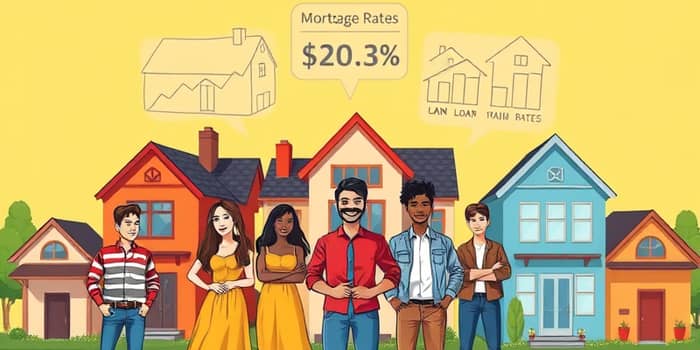Deciding on a mortgage is one of the most consequential steps in the journey to homeownership. With interest rates shifting and loan products evolving, navigating this landscape can feel overwhelming. Yet, by understanding your options and arming yourself with up-to-date data, you can transform uncertainty into confidence. This guide will walk you through the major mortgage types, current market rates, key decision factors, and borrower strategies to help you secure the ideal financing for your dream home.
Understanding Your Mortgage Options
Mortgages come in a variety of structures designed to meet diverse financial needs and timelines. Fixed-rate and adjustable-rate mortgages dominate the market, but specialty loans often cater to unique circumstances. By comparing each category’s benefits and risks, you can pinpoint the best fit for your long-term plans and budget.
Fixed-rate loans are prized for interest rate remains the same over decades, fostering predictable monthly payments and stable budgeting. In contrast, adjustable-rate mortgages (ARMs) start with a fixed period—commonly five or seven years—followed by periodic adjustments linked to market indexes. This structure can offer initially lower interest rate savings, but borrowers must be prepared for potential payment increases down the line.
Beyond these staples, conventional loans split into conforming and nonconforming (jumbo) products, based on the $766,000 conforming limit for most U.S. areas in 2024. Government-backed options (FHA, VA, USDA) extend accessibility to first-time buyers, veterans, and rural homeowners. Additionally, portfolio loans, renovation mortgages, physician loans, non-QM products, and reverse mortgages fill out an array of specialized financing paths.
Examining Current Mortgage Rates
As of mid-2025, the average 30-year fixed rate stands at approximately 6.72%, with projections for Q3 ranging between 6.65% and 6.74%. The 15-year fixed rate averages 5.86%. Although these figures remain above the historic lows seen during the pandemic, they have eased slightly from peak levels over the past year.
Economists predict a modest downturn in rates toward the end of 2025, targeting a 30-year fixed range of 6.3% to 6.5%. Over a five-year horizon, there is potential for stabilization in the 4% to 5% range if inflation subsides and economic growth remains moderate. Keeping an eye on Federal Reserve policy, inflation metrics, and unemployment trends will help you time your mortgage lock-in for optimal savings.
Key Factors in Choosing a Mortgage
Selecting the right loan hinges on personal circumstances and market conditions. Begin by clarifying how long you intend to reside in the property. A fixed-rate mortgage suits buyers planning to stay for a decade or more, while an ARM may benefit those expecting to relocate or refinance within the initial fixed period.
- Loan size and property value: Conforming loans cap out at $766,000, with higher limits in costly regions. Jumbo loans require stricter qualifying criteria and costs.
- Down payment: Conventional loans often need as little as 3–5%, though less than 20% triggers private mortgage insurance (PMI).
- Credit score and debt-to-income: A minimum score of 620 is typical for conventional loans, with a debt-to-income ratio under 50%.
- Special circumstances: Professionals and investors may leverage physician loans, renovation mortgages, or portfolio loans.
Managing Costs and Potential Risks
Even with a fixed rate, unexpected expenses can disrupt your budget. Property taxes and homeowners insurance often rise, nudging monthly obligations higher over time. Those opting for ARMs must prepare for possible rate hikes after the introductory period.
Closing costs vary significantly by loan type; jumbo and government-backed loans usually incur higher fees. Additionally, choosing to wait for rates to drop carries the risk of market volatility. A slight delay could cost thousands if rates climb unexpectedly.
Staying informed and consulting trusted professionals can mitigate these risks. By locking in a competitive rate at the right moment and reviewing all associated fees, you can protect your finances and steer clear of unwelcome surprises.
Essential Numbers & Data Points
Strategies for Borrowers to Succeed
Effective borrowers become lifelong learners. Continuously monitor rate forecasts and trends to spot opportune moments for locking in your rate. Enrich your credit profile by reducing balances and avoiding new debts in the months ahead of application.
Shopping around remains indispensable. Rates and fees can differ by lender, so obtain multiple preapproval offers. A larger down payment often unlocks more favorable terms and lowers your monthly payment.
- Consult a mortgage advisor or financial planner to receive tailored financial advice and guidance.
- Consider refinancing if rates dip significantly, balancing closing costs against expected savings.
- Explore mortgage rate buy-downs or discount points when rates are high and you plan to stay long-term.
Looking Ahead: Industry Trends and Predictions
The mortgage landscape will continue to reflect broader economic forces. Federal Reserve policy, inflation data, and global events all ripple through borrowing costs. Meanwhile, lenders innovate with flexible underwriting and niche loan products—supporting buyers with unconventional income streams or specialized needs.
Affordability remains a pressing concern, but gradual rate declines and increased loan variety offer hope. By staying agile and informed, borrowers can seize emerging opportunities and secure financing on terms that fit their life plans.
Conclusion: Your Path to Mortgage Mastery
Journeying from mortgage novice to savvy borrower demands patience, research, and strategic action. By understanding each loan type, tracking current rates, assessing your personal situation, and leveraging professional guidance, you can transform a complex process into a clear roadmap. Remember: the right mortgage is more than a loan—it’s the foundation upon which your future home and financial well-being are built. With this knowledge and confidence, you’re ready to find, finance, and flourish in the home of your dreams.
References
- https://myhome.freddiemac.com/blog/homebuying/understanding-common-types-of-mortgage-loans
- https://www.noradarealestate.com/blog/mortgage-rates-predictions-for-the-next-6-months-august-to-december-2025/
- https://www.schwab.com/learn/story/types-of-mortgage-loans
- https://www.mycvcu.org/blog/are-mortgage-interest-rates-expecting-to-come-down-in-2025
- https://www.bankrate.com/mortgages/types-of-mortgages/
- https://themortgagereports.com/32667/mortgage-rates-forecast-fha-va-usda-conventional
- https://www.bankofamerica.com/mortgage/learn/understanding-mortgage-options/
- https://themortgagereports.com/61853/30-year-mortgage-rates-chart










